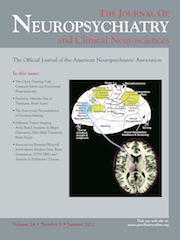Aripiprazole Monotherapy-Related Gray-Matter Growth in a Patient With First-Episode Drug-Naïve Non-Psychotic Major Depressive Disorder
To the Editor: Aripiprazole, a kind of D2 partial agonist antipsychotic, is approved for major depressive disorder (MDD) add-on therapy. It is believed to be related to its 5-HT1A partial agonist, 5-HT2C antagonist and 5-HT2A antagonist property. Here I want to present a case of first-episode drug-naïve nonpsychotic MDD with improvements of symptoms after 6-week treatment. Magnetic resonance imaging (MRI) structural analysis also revealed gray matter (GM) growth and brain volume (BV) increase within 6 weeks.
Case Report
Miss L is a 47-year-old female patient with first-episode drug-naïve MDD for 1-2 months. No specific physical illness, psychotic features, past manic episodes, nonpsychiatric medication use and substance abuse were mentioned. The symptoms of typical depression were mentioned, such as distinct depressed mood, suicide ideation, lack of interest, lack of energy, psychomotor agitation and sleep disturbances [Hamilton Rating Scale for Depression (HRSD): 32]. After visiting my clinic, she started to receive aripiprazole monotherapy as 2.5 mg/day and then the dose was titrated to 5 mg within 1 week without any significant side effects except mild headache and dizziness. No significant extrapyramidal side effects were mentioned. After 6 weeks of therapy, her MDD symptoms improved (HRSD: 13).
Structural brain magnetic resonance imaging (MRI) scans were obtained with 3T Siemens version scanner housed at MR Center, National Yang Ming University. Scans with three-dimensional fast spoiled gradient-echo recovery (3D-FSPGR) T1W1 (TR 2530ms; TE 3.03ms; slice thickness=1mm (no gap);192slices; matrix = 224×256; field of view: 256mm; number of excitation=1) were performed at first visit and 6th week visit. Her body weight was 71.2 kg at baseline and 71.7 kg at 6th week. Structural MRI was preprocessed with Structural Image Evaluation, using Normalization, of Atrophy (SIENAX) function of FSL (FMRIB Software Library) to calculate single time point GM, WM, and BV after registering and normalizing to template. The brain morphology change was estimated by SIENA function to calculate percentage BV change (PBVC). After analyzing brain MRI structure by SIENAX, GM increased from 750145.59 to 790751.54 within 6 weeks and PBVC is 0.0352900, which suggested BV increase after aripiprazole treatment (Figure 1).

Blue color represented atrophy and red color represented growth of BV. A positive estimated PBVC value represented BV increase.
Discussion
According to study of Frodl et al., MDD is associated with GM deficits over amygdala, hippocampus, prefrontal cortex, and anterior cingulate cortex.1 These regional GM deficits are related to their symptoms severity and even represent a kind of “trait marker” for MDD.2 GM growth effects might be related to the following reasons, such as synaptic remodeling and neurogenesis3 from the stimulation of neutrophic factors by antipsychotics,4 prevention of oxidative stress or 6-OH-dopamine lesioning and with subsequent increased glial cell proliferation in frontal cortex.5
1 : Depression-related variation in brain morphology over 3 years: effects of stress? Arch Gen Psychiatry 2008; 65:1156–1165Crossref, Medline, Google Scholar
2 : First episode drug-naïve major depressive disorder with panic disorder: gray matter deficits in limbic and default network structures. Eur Neuropsychopharmacol 2010; 20:676–682Crossref, Medline, Google Scholar
3 : Antipsychotic drugs and neuroplasticity: insights into the treatment and neurobiology of schizophrenia. Biol Psychiatry 2001; 50:729–742Crossref, Medline, Google Scholar
4 : Olanzapine counteracts reduction of brain-derived neurotrophic factor and TrkB receptors in rat hippocampus produced by haloperidol. Neurosci Lett 2004; 356:135–139Crossref, Medline, Google Scholar
5 : Effects of antipsychotic drugs on neurogenesis in the forebrain of the adult rat. Neuropsychopharmacology 2004; 29:1230–1238Crossref, Medline, Google Scholar



